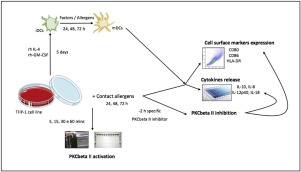当前位置:
X-MOL 学术
›
Toxicol. Lett.
›
论文详情
Our official English website, www.x-mol.net, welcomes your
feedback! (Note: you will need to create a separate account there.)
MECHANISTIC UNDERSTANDING OF DENDRITIC CELL ACTIVATION IN SKIN SENSITIZATION: ADDITIONAL EVIDENCES TO SUPPORT POTENCY CLASSIFICATION
Toxicology Letters ( IF 2.9 ) Pub Date : 2020-04-01 , DOI: 10.1016/j.toxlet.2020.01.014 Vlentina Galbiati 1 , Marina Marinovich 2 , Emanuela Corsini 1
Toxicology Letters ( IF 2.9 ) Pub Date : 2020-04-01 , DOI: 10.1016/j.toxlet.2020.01.014 Vlentina Galbiati 1 , Marina Marinovich 2 , Emanuela Corsini 1
Affiliation

|
Allergic contact dermatitis (ACD) is an important occupational and environmental disease caused by topical exposure to chemical allergens. In the EU, it has been calculated that 4% of animals are used in toxicity test for the assessment of skin sensitization [1]. To come a complete replacement of animals, evaluation of relative skin sensitization potency is necessary. The identification of mechanisms influencing allergen potency requires a better understanding of molecular events that trigger cell activation. Therefore, (i) the effects of selected allergens on surface markers expression and cytokines release in contact allergen-induced cell activation were assessed, and (ii) the role of Protein Kinase C (PKC) beta activation in contact allergen-induced cell activation was investigated. The human pro-myelocytic cell line THP-1 was used as experimental model surrogate of dendritic cells. Cells were exposed to select contact allergens of different potency and cell surface marker expression (CD80, CD86, HLA-DR) was determined by flow cytometry analysis. Cytokines production (IL-6, IL-8, IL-10, IL-12p40, IL-18) was evaluated with specific sandwich ELISA. The effective contribution of PKC beta in chemical allergen-induced cell activation was assessed by Western Blot analysis (PKC beta activation) and using a specific PKC beta inhibitor (PKC beta pseudosubstrate). In addition, to investigate if contact allergens are able to induce indeed dendritic cells (DCs) maturation, THP-1 cells were differentiated to immature DC and then exposed to contact allergen of different potency. Overall, our finding provides insights into the process of sensitization and strength of cell activation associated with allergens of different potency. Results obtained suggest that contact allergens of different potency are able to induce a different degree of activation of dendritic cells maturation involved in the process of ACD.
中文翻译:

皮肤致敏中树突状细胞活化的机制理解:支持效力分类的其他证据
过敏性接触性皮炎(ACD)是由局部接触化学过敏原引起的一种重要的职业和环境疾病。在欧盟,据计算有 4% 的动物用于毒性试验以评估皮肤致敏性 [1]。为了完全替代动物,必须评估相对的皮肤致敏效力。确定影响过敏原效力的机制需要更好地了解触发细胞活化的分子事件。因此,(i) 评估了所选过敏原对接触过敏原诱导细胞活化中表面标志物表达和细胞因子释放的影响,以及 (ii) 蛋白激酶 C (PKC) β 活化在接触过敏原诱导细胞活化中的作用是调查。人类前髓细胞系 THP-1 用作树突细胞的实验模型替代物。将细胞暴露于选择的不同效力的接触过敏原,并通过流式细胞术分析确定细胞表面标志物表达(CD80、CD86、HLA-DR)。细胞因子的产生(IL-6、IL-8、IL-10、IL-12p40、IL-18)用特异性夹心ELISA进行评估。PKC beta 在化学过敏原诱导的细胞激活中的有效贡献通过蛋白质印迹分析(PKC beta 激活)和使用特定的 PKC beta 抑制剂(PKC beta 假底物)进行评估。此外,为了研究接触过敏原是否能够真正诱导树突细胞 (DC) 成熟,将 THP-1 细胞分化为未成熟的 DC,然后暴露于不同效力的接触过敏原。全面的,我们的发现提供了对与不同效力的过敏原相关的致敏过程和细胞活化强度的见解。获得的结果表明,不同效力的接触过敏原能够诱导不同程度的树突状细胞成熟活化,参与 ACD 过程。
更新日期:2020-04-01
中文翻译:

皮肤致敏中树突状细胞活化的机制理解:支持效力分类的其他证据
过敏性接触性皮炎(ACD)是由局部接触化学过敏原引起的一种重要的职业和环境疾病。在欧盟,据计算有 4% 的动物用于毒性试验以评估皮肤致敏性 [1]。为了完全替代动物,必须评估相对的皮肤致敏效力。确定影响过敏原效力的机制需要更好地了解触发细胞活化的分子事件。因此,(i) 评估了所选过敏原对接触过敏原诱导细胞活化中表面标志物表达和细胞因子释放的影响,以及 (ii) 蛋白激酶 C (PKC) β 活化在接触过敏原诱导细胞活化中的作用是调查。人类前髓细胞系 THP-1 用作树突细胞的实验模型替代物。将细胞暴露于选择的不同效力的接触过敏原,并通过流式细胞术分析确定细胞表面标志物表达(CD80、CD86、HLA-DR)。细胞因子的产生(IL-6、IL-8、IL-10、IL-12p40、IL-18)用特异性夹心ELISA进行评估。PKC beta 在化学过敏原诱导的细胞激活中的有效贡献通过蛋白质印迹分析(PKC beta 激活)和使用特定的 PKC beta 抑制剂(PKC beta 假底物)进行评估。此外,为了研究接触过敏原是否能够真正诱导树突细胞 (DC) 成熟,将 THP-1 细胞分化为未成熟的 DC,然后暴露于不同效力的接触过敏原。全面的,我们的发现提供了对与不同效力的过敏原相关的致敏过程和细胞活化强度的见解。获得的结果表明,不同效力的接触过敏原能够诱导不同程度的树突状细胞成熟活化,参与 ACD 过程。











































 京公网安备 11010802027423号
京公网安备 11010802027423号